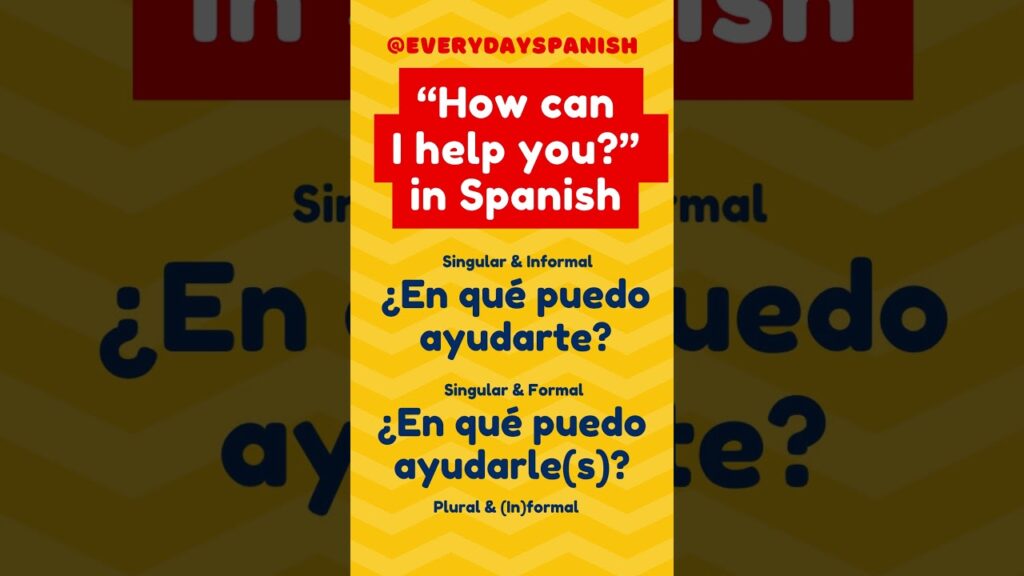How to Say “How Can I Help You?” in Spanish
When greeting customers or clients in a professional setting, it’s important to have a polite and effective way to offer assistance. In Spanish, there are several ways to ask “How can I help you?” that vary based on formality and number of people addressed. In this article, we’ll explore the different ways to phrase this question and provide guidance on when to use each version.
Informal Singular: “¿Cómo puedo ayudarte?”
The most informal way to ask “How can I help you?” in Spanish is by using the singular informal pronoun “tú” and the verb “ayudar” conjugated accordingly. This version is appropriate when addressing a single person you are familiar with or someone younger than you.Example:
- “¿Cómo puedo ayudarte con tus compras?”
(How can I help you with your shopping?)
Informal Singular: “¿En qué te puedo ayudar?”
Another informal singular option is to use the phrase “en qué” (in what) followed by the conjugated verb “ayudar.” This version is also suitable for addressing a single person informally.Example:
- “¿En qué te puedo ayudar hoy?”
(How can I help you today?)
Informal Singular: “¿En qué puedo servirte?”
A third informal singular option is to use the verb “servir” (to serve) instead of “ayudar.” This phrase is also appropriate for addressing a single person informally.Example:
- “¿En qué puedo servirte?”
(How can I serve you?)
Formal Singular: “¿Cómo puedo ayudarle?”
When addressing a single person formally, such as a customer or a person of higher status, use the formal pronoun “usted” and the verb “ayudar” conjugated accordingly.Example:
- “¿Cómo puedo ayudarle con su pedido?”
(How can I help you with your order?)
Formal Singular: “¿En qué le puedo ayudar?”
Another formal singular option is to use the phrase “en qué” followed by the conjugated verb “ayudar.” This version is also suitable for addressing a single person formally.Example:
- “¿En qué le puedo ayudar el día de hoy?”
(How can I help you today?)
Formal Singular: “¿En qué puedo servirle?”
A third formal singular option is to use the verb “servir” instead of “ayudar.” This phrase is also appropriate for addressing a single person formally.Example:
- “¿En qué puedo servirle, señor?”
(How can I serve you, sir?)
Plural: “¿Cómo puedo ayudarles?”
When addressing multiple people, use the plural pronoun “ustedes” and the verb “ayudar” conjugated accordingly.Example:
- “¿Cómo puedo ayudarles con sus compras?”
(How can I help you with your shopping?)
Plural: “¿En qué les puedo ayudar?”
Another plural option is to use the phrase “en qué” followed by the conjugated verb “ayudar.” This version is also suitable for addressing multiple people.Example:
- “¿En qué les puedo ayudar el día de hoy?”
(How can I help you today?)
Plural: “¿En qué puedo servirles?”
A third plural option is to use the verb “servir” instead of “ayudar.” This phrase is also appropriate for addressing multiple people.Example:
- “¿En qué puedo servirles, señores?”
(How can I serve you, gentlemen?)
Choosing the Right Version
When deciding which version to use, consider the following factors:
- Formality: Use the informal versions when addressing friends, family members, or people younger than you. Use the formal versions when addressing customers, clients, or people of higher status.
- Number of People: Use the singular versions when addressing one person and the plural versions when addressing multiple people.
- Personal Preference: Some versions may sound more natural to you than others. Choose the one that feels most comfortable and appropriate for the situation.
Conclusion
Knowing how to ask “How can I help you?” in Spanish is essential for providing excellent customer service and making people feel welcome. By using the appropriate version based on formality and number of people, you can create a positive and professional interaction. Practice these phrases and adapt them to your specific needs to ensure smooth communication in Spanish-speaking environments.
FAQ Section
Q1: Can I use “¿Cómo puedo ayudarte?” in a formal setting?
A1: While “¿Cómo puedo ayudarte?” is grammatically correct, it may come across as too informal in a formal setting. It’s best to use the formal singular version “¿Cómo puedo ayudarle?” when addressing a single person formally.
Q2: Is there a difference between “¿En qué te puedo ayudar?” and “¿En qué puedo ayudarte?”
A2: No, both “¿En qué te puedo ayudar?” and “¿En qué puedo ayudarte?” are informal singular versions of “How can I help you?” The choice between using “te” or not is a matter of personal preference and does not change the meaning.
Q3: Can I use “¿En qué puedo servirle?” when addressing multiple people?
A3: Yes, you can use “¿En qué puedo servirle?” when addressing multiple people formally. However, it’s more common to use the plural version “¿En qué puedo servirles?” when addressing more than one person.
Q4: Is there a difference between “ayudar” and “servir” in these phrases?
A4: Both “ayudar” and “servir” can be used to ask “How can I help you?” The main difference is that “ayudar” means “to help,” while “servir” means “to serve.” The choice between the two depends on personal preference and the specific context.
Q5: Can I use “¿Cómo puedo ayudarles?” when addressing a single person formally?
A5: No, “¿Cómo puedo ayudarles?” is a plural version and should only be used when addressing multiple people. When addressing a single person formally, use “¿Cómo puedo ayudarle?” instead.For more information on Spanish grammar and vocabulary, you can refer to the Wikipedia page on Spanish Language.



